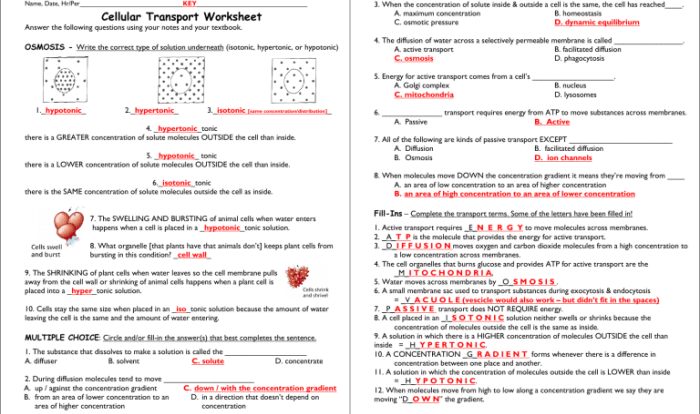Delving into the realm of cell transport, we present the ultimate guide—cell transport graphic organizer answers. This comprehensive resource empowers you to grasp the intricate mechanisms that govern the movement of substances across cell membranes, shaping the very essence of life.
From passive and active transport to endocytosis and exocytosis, this guide unveils the fundamental processes that enable cells to exchange nutrients, eliminate waste, and maintain homeostasis. Dive into the depths of cell transport and unravel the secrets that orchestrate the symphony of life.
Introduction to Cell Transport
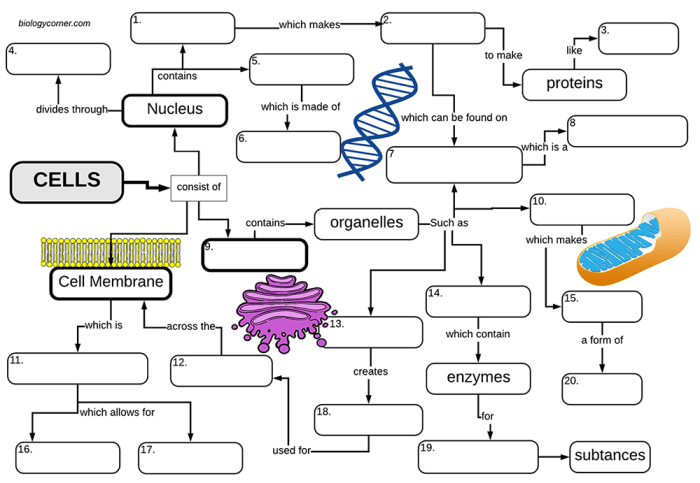
Cell transport refers to the movement of molecules and ions across the cell membrane. It is essential for various cellular functions, including nutrient uptake, waste removal, and cell signaling. There are two main types of cell transport: passive and active transport.
Passive Transport
Passive transport is a type of cell transport that does not require energy. It occurs when molecules or ions move from an area of high concentration to an area of low concentration. There are three main types of passive transport: diffusion, osmosis, and facilitated diffusion.
- Diffusion: The movement of molecules from an area of high concentration to an area of low concentration.
- Osmosis: The movement of water across a semipermeable membrane from an area of low solute concentration to an area of high solute concentration.
- Facilitated diffusion: The movement of molecules across a membrane with the help of a carrier protein.
Passive transport is essential for many cellular functions, such as the uptake of nutrients and the removal of waste products.
Active Transport: Cell Transport Graphic Organizer Answers
Active transport is a type of cell transport that requires energy. It occurs when molecules or ions move from an area of low concentration to an area of high concentration. There are two main types of active transport: primary active transport and secondary active transport.
- Primary active transport: The movement of molecules or ions across a membrane against a concentration gradient using energy from ATP.
- Secondary active transport: The movement of molecules or ions across a membrane against a concentration gradient using energy from another molecule or ion that is moving down its concentration gradient.
Active transport is essential for many cellular functions, such as the uptake of nutrients and the removal of waste products.
Endocytosis and Exocytosis
Endocytosis and exocytosis are two types of cell transport that involve the movement of large molecules or particles across the cell membrane. Endocytosis is the process of taking material into the cell, while exocytosis is the process of releasing material from the cell.
- Endocytosis: The process of taking material into the cell. There are three main types of endocytosis: phagocytosis, pinocytosis, and receptor-mediated endocytosis.
- Exocytosis: The process of releasing material from the cell.
Endocytosis and exocytosis are essential for many cellular functions, such as the uptake of nutrients and the removal of waste products.
Cell Transport in Plants
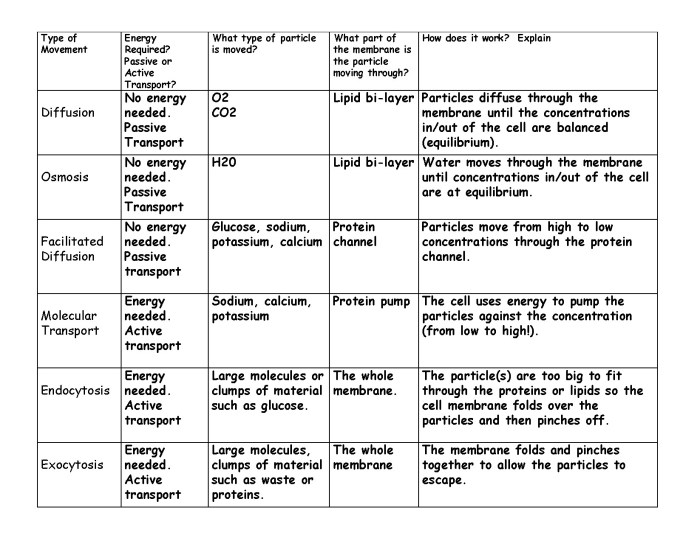
Cell transport in plants is similar to cell transport in animals, but there are some unique features. One of the most important differences is that plant cells have a cell wall. The cell wall is a rigid structure that surrounds the cell membrane and provides support and protection.
The cell wall also affects the movement of molecules and ions across the cell membrane.
Another unique feature of cell transport in plants is the presence of vacuoles. Vacuoles are large, fluid-filled organelles that occupy a large portion of the cell. Vacuoles store water, nutrients, and waste products. They also help to maintain the cell’s turgor pressure.
Cell Transport in Animals
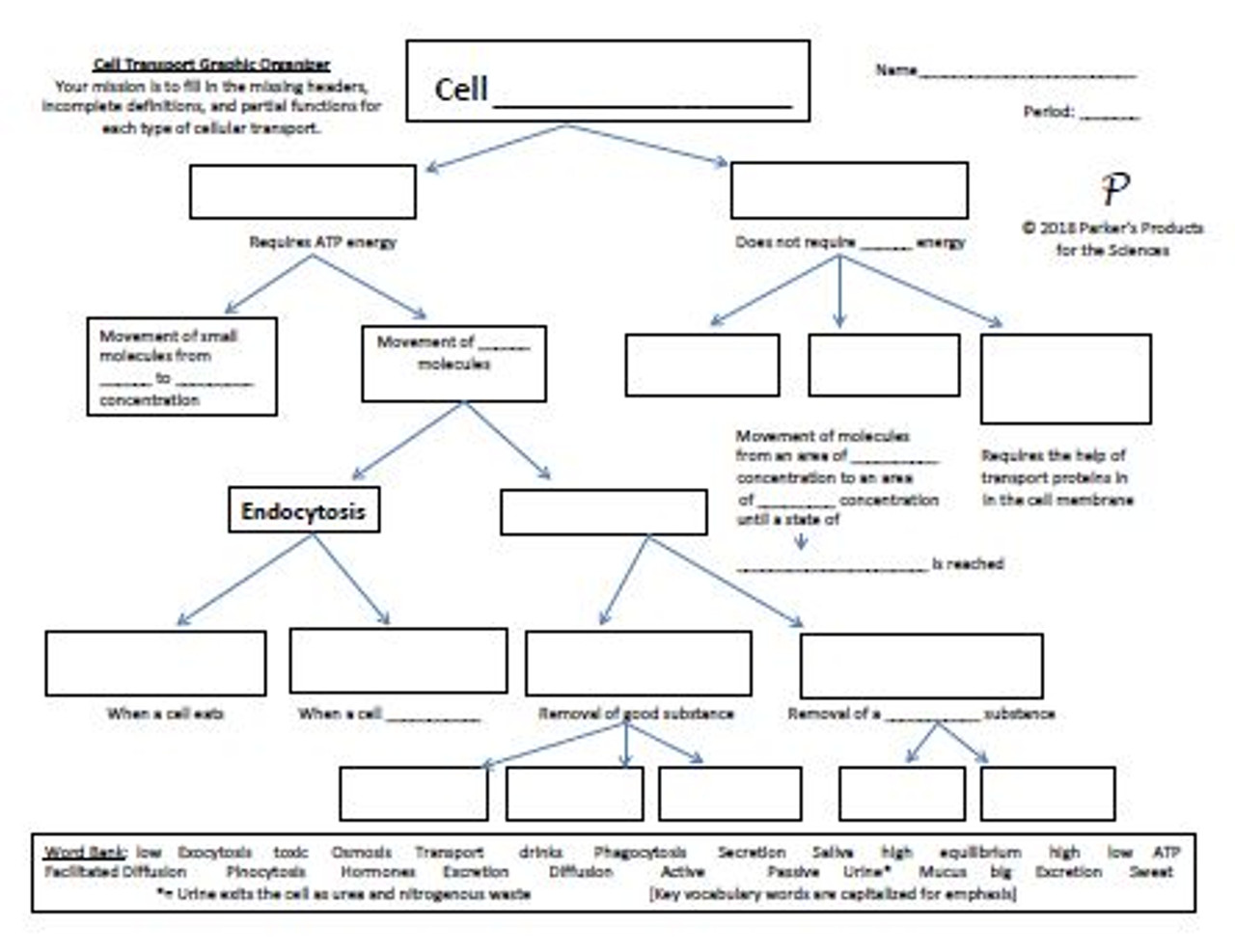
Cell transport in animals is similar to cell transport in plants, but there are some unique features. One of the most important differences is that animal cells do not have a cell wall. The plasma membrane is the only barrier between the cell and its surroundings.
Another unique feature of cell transport in animals is the presence of the cytosol. The cytosol is the fluid-filled interior of the cell. It contains all of the cell’s organelles and molecules.
Cell Transport and Disease
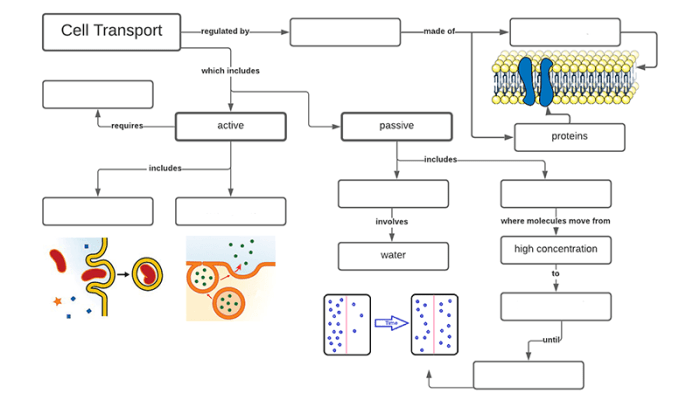
Cell transport is essential for many cellular functions. When cell transport is impaired, it can lead to a variety of diseases. Some of the most common diseases that are caused by impaired cell transport include:
- Cystic fibrosis: A disease that is caused by a defect in the CFTR protein. The CFTR protein is a chloride channel that is located in the cell membrane. When the CFTR protein is defective, it cannot transport chloride ions across the cell membrane.
This leads to a buildup of chloride ions in the cells, which can damage the cells and lead to a variety of symptoms, including respiratory problems, digestive problems, and infertility.
- Sickle cell anemia: A disease that is caused by a defect in the hemoglobin protein. Hemoglobin is a protein that is found in red blood cells. It is responsible for carrying oxygen from the lungs to the rest of the body.
When the hemoglobin protein is defective, it can cause red blood cells to become sickle-shaped. Sickle-shaped red blood cells are less able to flow through blood vessels, which can lead to a variety of symptoms, including pain, fatigue, and organ damage.
Cell transport is a complex and essential process. When cell transport is impaired, it can lead to a variety of diseases. Understanding cell transport is essential for understanding the causes and treatments of these diseases.
Query Resolution
What is the primary function of passive transport?
Passive transport facilitates the movement of substances across a concentration gradient, from an area of high concentration to low concentration, without requiring energy input.
How does active transport differ from passive transport?
Active transport utilizes energy to move substances against a concentration gradient, from an area of low concentration to high concentration.
What is the role of vesicles in endocytosis and exocytosis?
Vesicles are membrane-bound sacs that facilitate the transport of materials into (endocytosis) and out of (exocytosis) the cell.
